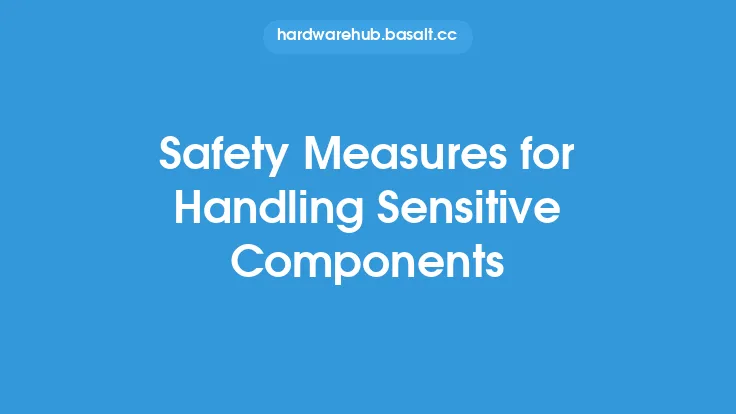When handling hardware, it's essential to take necessary precautions to prevent damage from electrostatic discharge (ESD). ESD can occur when two objects with different electrical potentials come into contact, resulting in a sudden flow of electricity. This can cause damage to sensitive electronic components, leading to malfunction or complete failure. To ensure safe hardware handling, it's crucial to understand the risks associated with ESD and take measures to mitigate them.
Introduction to ESD
ESD is a natural phenomenon that occurs when an object becomes electrically charged. This can happen through various means, such as friction, induction, or contact with other charged objects. When an object is electrically charged, it can attract or repel other objects, depending on the polarity of the charge. In the context of hardware handling, ESD can occur when a person touches a sensitive electronic component, causing a sudden discharge of electricity. This can damage the component, leading to costly repairs or replacement.
Types of ESD
There are several types of ESD, including human-body model (HBM), machine model (MM), and charged-device model (CDM). HBM ESD occurs when a person touches a sensitive electronic component, while MM ESD occurs when a machine or device comes into contact with a charged object. CDM ESD occurs when a charged device is placed in contact with a grounded object. Each type of ESD has different characteristics and requires specific precautions to prevent damage.
ESD Precautions
To prevent ESD damage, several precautions can be taken. One of the most effective methods is to use an anti-static wrist strap or ankle strap, which grounds the person handling the hardware and prevents the buildup of static electricity. Anti-static mats or surfaces can also be used to provide a grounded surface for handling hardware. Additionally, anti-static bags or packaging can be used to store and transport sensitive electronic components.
ESD Protection Devices
Several devices are available to protect against ESD, including surge protectors, ESD suppressors, and transient voltage suppressors. These devices can be used to protect sensitive electronic components from voltage spikes and surges, which can cause ESD damage. ESD protection devices can be installed in hardware, such as computers and networking equipment, to provide an additional layer of protection against ESD.
Grounding and Bonding
Grounding and bonding are critical components of ESD prevention. Grounding involves connecting an object to the earth, which provides a path for electricity to flow to the ground. Bonding involves connecting two or more objects together, which ensures that they are at the same electrical potential. Grounding and bonding can be achieved through various means, including the use of grounding straps, bonding straps, or grounding mats.
ESD-Safe Handling Procedures
To ensure safe handling of hardware, several procedures can be followed. First, handlers should wear anti-static clothing, including wrist straps and ankle straps, to prevent the buildup of static electricity. Second, handlers should touch a grounded object, such as a metal table or a grounding mat, before handling sensitive electronic components. Third, handlers should handle components by the edges, rather than touching the electrical contacts. Finally, handlers should avoid touching their face or hair, which can generate static electricity.
ESD-Safe Storage and Transportation
Sensitive electronic components should be stored and transported in ESD-safe packaging, such as anti-static bags or containers. These packaging materials are designed to prevent the buildup of static electricity and protect the components from ESD damage. Additionally, components should be stored in a dry, cool environment, away from direct sunlight and moisture.
ESD Testing and Measurement
To ensure that ESD precautions are effective, testing and measurement can be performed. Several devices are available to measure ESD, including ESD meters and ESD testers. These devices can be used to measure the electrical potential of an object and detect the presence of static electricity. Additionally, ESD testing can be performed to ensure that hardware is properly grounded and bonded.
Conclusion
In conclusion, ESD precautions are essential for safe hardware handling. By understanding the risks associated with ESD and taking measures to mitigate them, handlers can prevent damage to sensitive electronic components. ESD precautions, including the use of anti-static wrist straps, grounding and bonding, and ESD-safe handling procedures, can help to prevent ESD damage. Additionally, ESD testing and measurement can be performed to ensure that precautions are effective. By following these guidelines, handlers can ensure the safe handling of hardware and prevent costly repairs or replacement.





